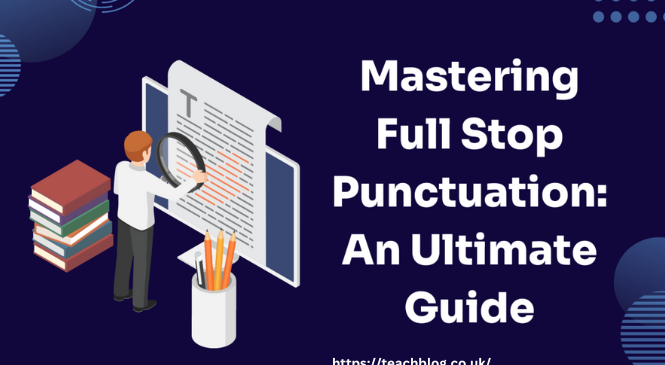Table of Contents
Introduction to Full Stop Punctuation
When it comes to writing, punctuation is more than just a set of rules. It’s a tool that shapes meaning and adds rhythm to your words. One often overlooked yet powerful mark is the full stop punctuation. This small dot at the end of a sentence does far more than signify completion; it serves as an essential guide for readers navigating through your thoughts.
In this digital age, where attention spans are shorter than ever, getting your message across clearly has never been more vital. Understanding how to utilize full stops effectively can elevate your writing from mundane to memorable. Whether you’re drafting an email, crafting a blog post, or penning the next great novel, mastering full stop punctuation can make all the difference in ensuring clarity and engagement with your audience.
Let’s explore seven creative ideas on how to leverage this simple but impactful piece of punctuation in your writing!
The Importance of Using Full Stops
Full stops play a crucial role in writing. They signal the end of a thought, allowing readers to pause and process information. This clarity enhances comprehension.
Using full stops correctly helps maintain structure within your text. Each complete sentence stands out, guiding readers through your ideas seamlessly. Without them, writing can become a jumbled mess, leading to confusion.
Moreover, full stops contribute to the overall rhythm of your piece. They create natural breaks that enhance flow and readability. Short sentences punctuated effectively can pack a powerful punch.
Neglecting this punctuation mark may result in miscommunication or unintended ambiguity. Readers appreciate clear direction; proper use of full stops provides just that.
In any written work—be it an article or creative storytelling—the importance of using full stop punctuation cannot be overstated. It is foundational for effective communication and reader engagement.
Writing with Clarity and Structure
When it comes to writing, clarity is essential. Full stop punctuation plays a crucial role in achieving this.
Each complete thought deserves its own space. By placing a full stop at the end of a sentence, you signal the end of one idea and prepare your reader for another. This separation fosters understanding.
Structure also enhances readability. Well-placed full stops create rhythm in your text. They help break up long paragraphs into digestible pieces.
Using them effectively can guide readers through complex concepts without overwhelming them. When sentences flow logically from one to the next, ideas become more accessible.
Readers appreciate brevity and precision. Clear sentences lead to stronger engagement with your content, allowing your message to shine through effortlessly.
Idea 1: Using Full Stop Punctuation for Complete Sentences
Full stop punctuation plays a crucial role in writing. It signals the end of a complete thought. Without it, sentences might run on indefinitely, leaving readers confused.
Using full stops effectively ensures clarity. Each sentence stands alone, delivering its message with precision. This separation allows readers to digest information easily.
Incorporating complete sentences enhances your style too. It elevates your prose and makes it more engaging. Readers appreciate well-structured content that flows smoothly from one idea to another.
Remember, every time you use a full stop, you’re giving the reader a moment to pause and reflect on what they’ve just read. It’s not just about grammar; it’s about creating an experience that resonates with your audience.
Idea 2: Emphasizing Key Points with a Full Stop Punctuation
Using full stop punctuation can bring attention to key points in your writing. When you place a period at the end of a significant statement, it creates a moment for readers to pause and reflect.
This deliberate break ensures that your message resonates. It transforms ordinary statements into powerful declarations. Consider this: “Climate change is real.” This simple sentence carries weight when punctuated correctly.
When emphasizing critical ideas, fewer words can often have greater impact. A well-placed full stop after an essential truth adds gravity to it. Readers absorb more when they encounter these decisive moments.
Don’t hesitate to use short sentences strategically in your work. An impactful thought deserves its own space on the page. Let each point stand alone, allowing it to shine through clarity and precision with every full stop used effectively.
Idea 3: Creating Suspense or Drama
Using full stop punctuation strategically can heighten suspense in your writing. A well-placed period adds weight to a sentence, leaving readers hanging on the edge of their seats.
Imagine crafting a scene where tension builds slowly. You write: “The door creaked open.” Then, pause for effect with a full stop. This single moment allows anticipation to swell.
After that break, you might continue: “Someone stepped inside.” The stark contrast created by the period amplifies curiosity. Readers are compelled to ask questions about what happens next.
Employing this technique is powerful. It transforms mundane moments into thrilling cliffhangers. Your audience will feel invested and eager for resolution as they navigate through each carefully punctuated line.
Suspense thrives on uncertainty, and precise use of full stops fuels that uncertainty beautifully. Each abrupt halt invites deeper engagement with the story unfolding before them.
Idea 4: Indicating a Pause or Change in Tone
A full stop can do wonders when it comes to pacing your writing. It allows readers to breathe and absorb what they just read.
When you introduce a new idea or shift gears in your narrative, placing a period at the end of a sentence signals that change effectively. This technique can enhance understanding.
For instance, consider how shifting from dialogue to exposition might feel jarring without proper punctuation. A well-placed full stop separates these elements clearly, guiding the reader through the transition smoothly.
Additionally, using periods strategically can create rhythm in your text. It encourages pauses that add weight to significant statements or shifts in tone.
This method not only enhances clarity but also engages readers more deeply by inviting them to reflect on each segment before moving forward.
Idea 5: Conveying Strong Emotions
Strong emotions can transform simple sentences into powerful expressions. A well-placed full stop allows feelings to resonate deeply with readers.
When you want to convey anger, joy, or sadness, a full stop punctuates the raw intensity of your words. It creates a moment of pause that invites reflection. This space is where emotion settles in.
Consider this: “I can’t believe you did that.” Pause. “It hurt me.” The second sentence hits harder because of the deliberate break before it.
Using full stops helps emphasize urgency and importance too. Each statement stands tall on its own, enhancing the emotional weight behind your message.
In creative writing or personal narratives, such moments become memorable experiences for readers. They linger long after they’ve moved on from the text, making them feel connected to your story’s core emotions.
Idea
There’s no denying that full stop punctuation plays a vital role in writing. It provides clarity and structure, guiding readers through your thoughts.
Another idea is to use full stops to create rhythm in your writing. By varying sentence lengths and strategically placing full stops, you can control the flow of the text. This technique keeps readers engaged while allowing critical points to stand out.
Using these strategies not only enhances readability but also elevates your overall message. Embrace the power of full stop punctuation as you craft compelling narratives or informative pieces. Your audience will appreciate the clarity and impact it brings.


















